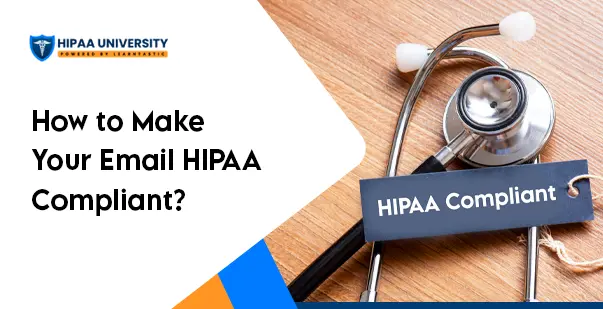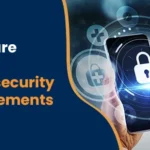How to Make Your Email HIPAA Compliant

August 7, 2024
Table of Contents:
- Introduction
- Understanding HIPAA Requirements
- Why HIPAA Compliant Emails Are Important
- Steps to Ensure Your Email is HIPAA Compliant
- Best Practices for HIPAA Compliant Secure Email
- Common Mistakes to Avoid
- Case Study: Successful HIPAA Compliant Email Implementation
- Advanced Measures for Enhanced HIPAA Email Compliance
- Legal and Ethical Considerations
- Real-World Examples of HIPAA Compliance Breaches
- Improving HIPAA Email Compliance with Technology
- Practical Tips for Everyday HIPAA Email Compliance
- Summary Checklist for HIPAA Compliant Emails
- Final Words
Introduction
Email is the main form of communication in the modern digital world, even in healthcare. It simplifies communication with patients, insurers, and providers. However, handling confidential patient information brings risks that surpass the benefits. So, it is vital to ensure to conform to HIPAA compliant email.
HIPAA requires healthcare providers to keep patient information private and secure. This involves implementing strong safety protocols to protect personal information. Hence, understanding and adhering to HIPAA requirements is essential for any healthcare organization.
Ensuring that emails follow HIPAA involves several steps, including establishing access limits, encrypting emails, and reviewing your email service provider. Staff training on HIPAA and secure email is also essential. By following these rules, you can protect and effectively use email.
Understanding HIPAA Requirements
HIPAA sets the standard for safeguarding confidential patient data. Any company handling protected health information (PHI) must ensure appropriate physical security measures, network security, and procedures are in place. This involves regularly taking these actions. To protect PHI, these standards must also be applied to emails.
Why HIPAA-Compliant Emails Are Important
Emails that comply with HIPAA prevent unauthorized access to PHI. Noncompliance could result in major consequences, such as severe fines and damage to one’s reputation. Thus, it is essential to understand and implement HIPAA email encryption and security procedures. Any healthcare organization must protect patient information by using compliant emails.
Steps to Ensure Your Email is HIPAA Compliant
Ensuring your email system is HIPAA compliant involves several key steps. These steps help protect patient information and maintain adherence to regulations.
-
Assess Your Email Provider
Ensure your email provider supports HIPAA compliance. Major providers like Google and Microsoft offer HIPAA-compliant email services. You must sign a Business Associate Agreement (BAA) with them.
-
Encrypt Your Emails
HIPAA requires encrypting emails that contain PHI. Encryption makes the information unreadable to unauthorized users. Here’s how to ensure your email meets HIPAA email encryption requirements:
- Use strong encryption standards (e.g., TLS for email in transit).
- Ensure end-to-end encryption for complete security.
- Maintain current encryption keys with frequent revisions and oversight.
-
Implement Access Controls
Access controls prevent unauthorized access to PHI. Ensure that sensitive information can only be accessed by authorized workers. Implement the following:
- Unique user IDs for all employees.
- Update strong passwords to prevent breaches.
- Two-factor authentication (2FA) for additional protection.
-
Train Your Staff
Staff should be aware of HIPAA compliance requirements. Provide consistent guidance to safeguard sensitive health data correctly. Focus on the following areas:
- Identifying PHI.
- Proper email handling practices.
- Recognizing phishing attempts and suspicious emails.
-
Secure Email Transmission
Ensuring secure transmission of emails is vital. Follow these practices:
- Use a secure email service that complies with HIPAA regulations.
- Avoid using public Wi-Fi for sending PHI.
- Verify the recipient’s email address before sending.
-
Monitor and Audit Email Activity
Regular monitoring and auditing can help identify potential security breaches. Implement the following:
- Keep track of email activities to monitor changes and access.
- Carry out routine evaluations to guarantee compliance.
- Use intrusion detection systems to identify unauthorized access.
-
Develop an Email Retention Policy
A clear email retention policy helps manage PHI. Ensure that you securely store and dispose of emails. Your policy should include:
- Retention periods for different types of emails.
- Secure storage solutions.
- Proper disposal methods for old emails.
Best Practices for HIPAA-Compliant Secure Email
To maintain a secure and HIPAA-compliant email system, adhering to best practices is essential. These practices will make your emails effective and protect patient data. Follow these practices for maintaining a HIPAA compliant secure email system:
- Use HIPAA-Compliant Email Services: Choose services that declare HIPAA conformity in writing.
- Encrypt All Emails Containing PHI: Use strong encryption for transmitting and storing emails.
- Update Security Protocols:Keep up with the most recent security updates and implement them immediately.
- Educate Your Team: Ensure your team is knowledgeable about security best practices and HIPAA regulations.
- Conduct Regular Security Audits: Regular audits help identify and address risks.
Common Mistakes to Avoid
When adopting HIPAA-compliant email practices, it’s essential to stay clear of usual mistakes. It will be easier to keep your email communications secure and compliant if you identify and fix these errors. While implementing email HIPAA compliant practices, avoid these common mistakes:
- Not Using Encryption: Failing to encrypt emails is a significant compliance breach.
- Weak Access Controls: Poor access control measures can lead to unauthorized access.
- Inadequate Staff Training: Untrained staff are more likely to make security-compromising mistakes.
- Ignoring Regular Audits: Skipping audits can allow vulnerabilities to go unnoticed.
- Using Public Wi-Fi: Public networks are insecure and can expose PHI to unauthorized access
Case Study: Successful HIPAA-Compliant Email Implementation
Take a look at the following case study to see how HIPAA-compliant email practices can be successfully implemented. By taking important precautions, a healthcare provider successfully put into place a compliant email system. Their methodology functions as a template for accomplishing and upholding HIPAA regulations.
A healthcare provider used a methodical strategy to ensure that emails were HIPAA compliant. They chose a HIPAA-compliant email provider with a Business Associate Agreement (BAA) and strong security.
They then used strong encryption to ensure that any emails with PHI were encrypted per modern guidelines. Monthly training sessions focused on email security and HIPAA compliance.
To comply with HIPAA, the service set a strict email retention policy and conducted quarterly audits to find and fix any security flaws.
These steps made the provider fully HIPAA compliant. It cut data breach risks and improved their reputation.
Advanced Measures for Enhanced HIPAA Email Compliance
Putting advanced measures in place is essential to improving your HIPAA email compliance. These tactics go above and beyond the call of duty to offer extra security and safeguards for private patient data. To further fortify your HIPAA email compliance, consider these advanced measures:
- Implement Data Loss Prevention (DLP) Tools
DLP tools prevent sharing sensitive data outside the organization. These tools scan emails for PHI and apply security measures.
- Use Secure Email Gateways
Secure email gateways add security by removing viruses, spam, and phishing emails. They ensure that your mailbox receives only authentic, safe emails.
- Conduct Phishing Simulations
Regular phishing simulations help train staff to recognize and respond to phishing attempts. These simulations can reduce the likelihood of successful phishing attacks.
- Establish Incident Response Protocols
A clear incident response protocol ensures quick action during a security breach. It must stop the breach, alert those affected, and notify the police if needed.
- Update Software
Regularly updating your software fixes security flaws and protects against future attacks.
Legal and Ethical Considerations
Understanding the ethical, legal, and technical ramifications of HIPAA compliance is crucial. Recognize the need to maintain patient trust and understand the effects of data breaches.
- Legal Implications: Noncompliance with HIPAA regulations may result in serious fines and legal action. The penalty depends on the kind and severity of the violation.
- Ethical Considerations : Patient privacy and security demand strict moral and legal safeguards. Patients must continue to have faith in healthcare providers to protect their data.
Read more: What are the penalties for HIPAA violations?
Real-World Examples of HIPAA Compliance Breaches
Real-life examples of email HIPAA compliant violations show the need to follow HIPAA email standards. By learning from these examples, organizations can better understand the dangers. They can then take steps to prevent similar problems. Here are a few notable cases:
- Anthem Inc. (2015): A data breach resulting from a sophisticated cyberattack exposed the records of 78.8 million people and cost Anthem $16 million in settlement.
- University of California Los Angeles Health (2015): A cyberattack compromised the personal information of 4.5 million patients, leading to a $7.5 million settlement.
Improving HIPAA Email Compliance with Technology
Improving HIPAA email compliance is becoming more and more dependent on using modern technology. With the right tools, you can boost email security. They can keep private patient data safe. The following extra devices and tools can improve the security of your emails:
- Secure Messaging Platforms
These platforms offer secure methods for communicating PHI as an alternative to regular email. They often have receipts and message expiration, and they ensure compliance by default.
- Automated Compliance Management
Automated tools can manage and enforce HIPAA compliance regulations across your organization. These solutions audit email operations for compliance, classify PHI, and impose encryption standards.
- Blockchain Technology
Blockchain can improve email security and transparency. It creates an unchangeable record of emails and helps identify any changes.
Practical Tips for Everyday HIPAA Email Compliance
Using these helpful tips, including HIPAA compliance in your regular emails, can be simple:
- Double-Check Recipients: Always verify the recipient’s email address before sending PHI.
- Use Secure Email Labels: Label emails containing PHI as “Confidential” to alert recipients to their sensitive nature.
- Limit PHI in Emails: Whenever possible, limit the amount of PHI included in emails. Use secure portals for detailed information.
- Review Email Policies: Regularly revisit and revise your email guidelines to maintain relevance and compliance with the latest HIPAA regulations and best practices.
- Implement Role-Based Access: Ensure that only staff members who need access to PHI for their roles can access such information.
Summary Checklist for HIPAA-Compliant Emails
If you take the proper approach, integrating HIPAA compliance into your regular email routines can be simple. It can be simpler to make sure that your email exchanges always adhere to HIPAA regulations if you follow these helpful recommendations. To help you stay on track, here’s a quick checklist for creating email HIPAA compliants:
- Use a HIPAA compliant email provider and sign a BAA.
- Encrypt all emails containing PHI.
- Implement strong access controls.
- Provide ongoing HIPAA education to train staff on requirements.
- Use secure email transmission methods.
- Monitor and audit email activity.
- Develop and follow an email retention policy.
- Stay updated with security protocols.
- Conduct regular security audits.
- Use DLP tools to prevent unwanted data sharing.
- Implement secure email gateways.
- Conduct phishing simulations.
- Establish incident response protocols.
- Update software to patch vulnerabilities.
- Audit and refine compliance policies regularly.
- Perform regular risk assessments.
- Consult with HIPAA compliance experts.
- Foster a compliance culture within your organization.
By following this checklist, you can maintain the security and compliance of your email system.
Read more: HIPAA Compliance Checklist
Final Words
A HIPAA compliant email system must be set up to protect sensitive patient information and stay out of trouble with the law. To ensure your emails meet compliance, you must know and apply HIPAA’s email encryption rules and security practices. To maintain compliance, enforce strict access controls. Monitor systems and train employees regularly. By following these principles, you can protect PHI. This will reduce data breaches and improve your company’s reputation. HIPAA compliance protects data and builds trust with partners and patients.





